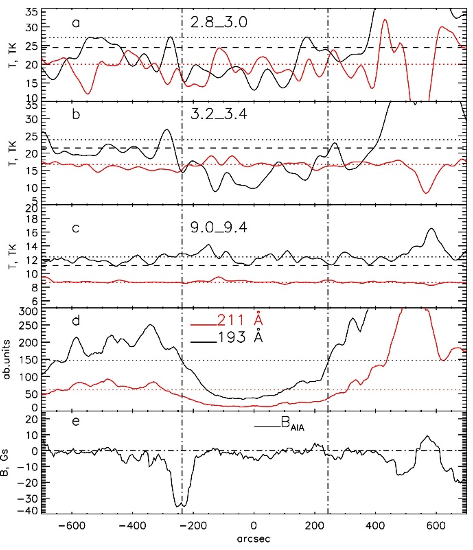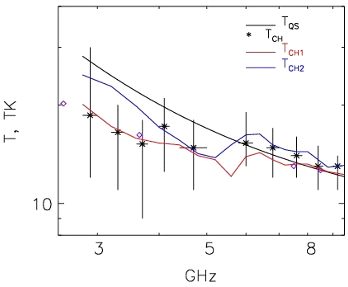Coronal holes (CHs) are regions of reduced brightness in solar disk images in extreme ultraviolet (EUV) or soft X-ray emissions corresponding to configurations with open magnetic field lines. Data on their area and depth of brightness depression is used in forecasts of solar wind parameters in the vicinity of Earth.
Regular two-dimensional observations of CHs in microwaves with a spatial resolution to 10–20“ began in the 1990s at frequencies of 5.7 GHz (SSRT) and 17 GHz (NoRH). At 5.7 GHz, there was generally a brightness temperature depression in CHs to 8·103 K with a brightness temperature of the quiet Sun 16·103 K. At 17 GHz, the contrast between CH and the quiet Sun is imperceptible, but in many cases sources of increased radio brightness were seen inside and on CH boundaries. Various reasons for the appearance of such heterogeneities at 17 GHz have been discussed: 1) microflares in the chromospheric network leading to energy release at CH bases; 2) concentration of open magnetic field lines in the chromosphere, which correspond to their increased divergence in the corona.
The purpose of this work is to analyze multiwave CH observations with the Siberian Radio Heliograph. We have examined characteristics of microwave structures within the boundaries of the CH observed in EUV emission in the central part of the solar disk on April 25 and September 20, 2023.
Observations
The full solar disk maps on April 25, 2023 obtained with the Siberian Radio Heliograph [Lesovoi et al., 2017; Altyntsev et al., 2020] at ~ 06:14 UT. Radio maps were built automatically in routine mode at 20 frequencies from 2.8 up to 9.4 GHz with signal accumulation time of 4 s at every frequency. To reduce noise, we additionally averaged images obtained at adjacent receiving frequencies.
Figure 1. Microwave maps averaged at frequencies of 2.8 GHz and 3.0 GHz (a), 9.0 GHz and 9.4 GHz (c). Background images were transformed by equalization and smoothing with 30″ window. White contours (panel a) show the depressions with levels 0.7TQS and 0.9TQS. Yellow contours show the EUV depressions at 0.5 level of the mean brightness of the SDO/AIA image in the 211 Å line. Panel b is an EUV image in the 211 Å channel. The brightness is cropped from above at 0.6 of the brightness average over the disk to highlight structures inside the CH. Panel d presents longitudinal field magnetograms transformed by equalization and smoothing with a window of 30″. Red lines indicate the cross-section for constructing brightness temperature profiles in Figure 2. Squares denote the regions for which the radio brightness histograms were analyzed.

Figure 2. Brightness temperature profiles in intensity (R+L, black solid line; R-L, red solid line) (a–c), plotted along the solar disk cross-sections depicted in Figures 1. Black dotted, dashed, and red dotted lines are the quiet Sun levels TQS, 0.9TQS, 0.7TQS. Panel d portrays brightness profiles in the 211 and 193 Å lines. Vertical dash-dot lines in all panels are the CH boundaries determined from by the EUV emission in the 193 Å channel; black and red dotted lines correspond to half the brightness in the corresponding channel. All profiles are smoothed by a 30″ window. Panel e presents the SDO/HMI magnetogram profile.
In Figure 3 we can see microwave spectrum on 25 April event (asterisks). The vertical bars show the limits of the pixel brightness scatterings inside the square boxes in Figure 1. There are also shown spectra of the quiet Sun, and two CHs on 23 September.

Figure 3. Spectrum of radio emission of the quiet Sun TQS (solid line) and brightness temperatures averaged over CH. Asterisks with bars indicate the spectrum of the April 25, 2023 CH. The bars show Tmax and Tmin inside the CH square. Lilac diamonds mark RATAN-600 measurements [Borovik et al., 1990]. Red and blue curves are the mean brightness temperatures recorded into two CHs on September 20, 2023.
Discussion and Conclusion
SRH radio maps allow us to confidently detect radio brightness depressions associated with CHs. In shape and size, the EUV emission depression regions are the closest to the microwave ones with brightness about 0.7TQS at frequencies ~3–4 GHz. Daily observations with SRH can be used, similarly to extra-atmospheric EUV images, to identify CHs on the solar disk.
Test observations with the Siberian Radio Heliograph have confirmed the results of CH observations obtained from multiwave one-dimensional scans from RATAN-600 and two-dimensional maps from SSRT (5.7 GHz) and the Nobeyama Radio Heliograph (17 GHz).
It follows from Figure 1 that the structures of reduced brightness with scales >100“ can be traced in the microwave range from 2.8 to 10 GHz. These structures do not clearly correlate with the distribution of the longitudinal magnetic field component. There are almost no marked spatial heterogeneities in EUV emission (see Figure 2). Pixel-to-pixel analysis of the brightness temperature in CH shows the presence of small-scale (several arcsec) heterogeneities. The pixel-to-pixel brightness scatterings at a frequency of 2.8 GHz reaches Tmax/Tmin=2.5, and with increasing frequency it decreases down to 1.3 at ~10 GHz.
Depressions manifest themselves at low frequencies, at which the contribution of the coronal layer is large, and are attributed to ~1.5 time lower plasma density and temperature in the corona above CH relative to the quiet Sun [Borovik et al., 1999].
The microwave radiation of the quiet Sun and CHs is generated by the bremsstrahlung mechanism and consists, in the first approximation, of radiation from two layers: the optically thick chromosphere and the optically thin corona. Depressions manifest themselves at low frequencies, at which the contribution of the coronal layer is large, and are attributed to ~1.5 time lower plasma density and temperature in the corona above CH relative to the quiet Sun [Borovik et al., 1999].
Test observations of coronal holes with two antenna arrays in 3–6 and 6–12 GHz ranges have shown the high diagnostic potential of the Siberian Radio Heliograph. Spectral observations with SRH will provide unique information about the dynamics and structure of the solar atmosphere over CHs from the chromosphere to the lower corona, as well as about the physical nature of heterogeneities inside CHs, including features of magnetic field distribution.
The use of regular mapping of the solar disk in applied problems of forecasting solar wind variations is promising. SRH observations can provide the main CH parameters employed in forecasting (location and shape of depression regions, depth of depression, flare activity at CH boundaries, brightness heterogeneities in CHs), which are currently obtained from extra-atmospheric observations of EUV emission.
Based on the recent paper: Altyntsev, A. T., Globa M.V., Meshalkina, N. S., Sych R.A. Observations of coronal holes with the Siberian Radio Heliograph: 2024, Solar-Terrestrial Physics, 10 (3), P.3-10, DOI: 10.12737/stp-103202401.
*Complete list of authors: Altyntsev1, A. T., Globa1, M.V., Meshalkina1, N. S., Sych1, R. A.
1Institute of Solar-Terrestrial Physics SB RAS, Lermontov St. 126A, Irkutsk 664033, Russia
References
- AltyntsevT., Lesovoi S.V., Globa M.V. et al.: Solar-Terr. Phys., 2020, 6 ( 2), 30.
- BorovikN., Kurbanov M.S., Livshits M.A. et al.: Soviet Astronomy, 1990, 34(5), 522.
- Borovik V.N., Medar V.G., Korzhavin A.N.: Lett. 1999, 25(4), 250.




















Discussion about this post